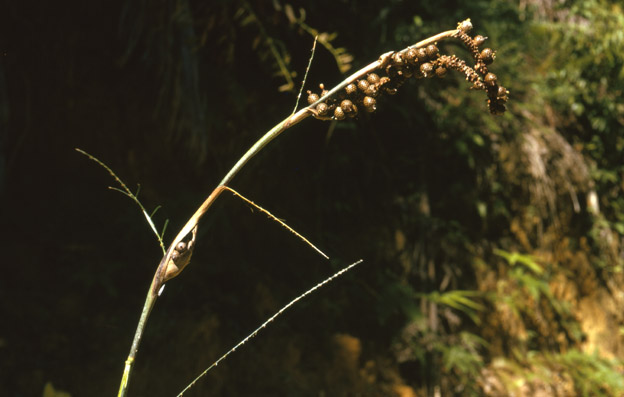- Acanthophoenix
- Acrocomia
- Actinokentia
- Actinorhytis
- Adonidia
- Aiphanes
- Allagoptera
- Ammandra
- Aphandra
- Archontophoenix
- Areca
- Arenga
- Asterogyne
- Astrocaryum
- Attalea
- Bactris
- Balaka
- Barcella
- Basselinia
- Beccariophoenix
- Bismarckia
- Borassodendron
- Borassus
- Brassiophoenix
- Burretiokentia
- Butia
- Calamus
- Calyptrocalyx
- Calyptrogyne
- Calyptronoma
- Carpentaria
- Carpoxylon
- Caryota
- Ceratolobus
- Ceroxylon
- Chamaedorea
- Chamaerops
- Chambeyronia
- Chelyocarpus
- Chuniophoenix
- Clinosperma
- Coccothrinax
- Cocos
- Corypha
- Cryosophila
- Cyphokentia
- Cyphophoenix
- Cyphosperma
- Daemonorops
- Deckenia
- Desmoncus
- Dictyocaryum
- Drymophloeus
- Dypsis
- Elaeis
- Eleiodoxa
- Eremospatha
- Eugeissona
- Euterpe
- Gaussia
- Geonoma
- Guihaia
- Hedyscepe
- Hemithrinax
- Howea
- Hyophorbe
- Hyospathe
- Hyphaene
- Iriartea
- Iriartella
- Itaya
- Jailoloa
- Johannesteijsmannia
- Juania
- Jubaea
- Jubaeopsis
- Kentiopsis
- Kerriodoxa
- Laccospadix
- Laccosperma
- Lanonia
- Latania
- Lemurophoenix
- Leopoldinia
- Lepidocaryum
- Lepidorrhachis
- Leucothrinax
- Licuala
- Linospadix
- Livistona
- Lodoicea
- Lytocaryum
- Manicaria
- Manjekia
- Marojejya
- Masoala
- Mauritia
- Mauritiella
- Maxburretia
- Medemia
- Metroxylon
- Myrialepis
- Nannorrhops
- Nenga
- Neonicholsonia
- Neoveitchia
- Nephrosperma
- Normanbya
- Nypa
- Oenocarpus
- Oncocalamus
- Oncosperma
- Orania
- Oraniopsis
- Parajubaea
- Pelagodoxa
- Phoenicophorium
- Phoenix
- Pholidocarpus
- Pholidostachys
- Physokentia
- Phytelephas
- Pigafetta
- Pinanga
- Plectocomia
- Plectocomiopsis
- Podococcus
- Pogonotium
- Ponapea
- Prestoea
- Pseudophoenix
- Ptychococcus
- Ptychosperma
- Raphia
- Ravenea
- Reinhardtia
- Retispatha
- Rhapidophyllum
- Rhapis
- Rhopalostylis
- Roscheria
- Roystonea
- Sabal
- Sabinaria
- Salacca
- Saribus
- Satakentia
- Satranala
- Schippia
- Sclerosperma
- Socratea
- Solfia
- Sommieria
- Syagrus
- Synechanthus
- Tahina
- Tectiphiala
- Thrinax
- Trachycarpus
- Trithrinax
- Veitchia
- Verschaffeltia
- Voanioala
- Wallaceodoxa
- Wallichia
- Welfia
- Wendlandiella
- Wettinia
- Wodyetia
- Zombia
- x Jubautia splendens
- ?? Acoelorrhaphe
- ?? Bentinckia
- ?? Brahea
- ?? Clinostigma
- ?? Colpothrinax
- ?? Copernicia
- ?? Cyrtostachys
- ?? Dictyosperma
- ?? Dransfieldia
- ?? Heterospathe
- ?? Hydriastele
- ?? Iguanura
- ?? Incertae sedis & excluded names
- ?? Loxococcus
- ?? Micronoma
- ?? Paripon
- ?? Pritchardia
- ?? Rhopaloblaste
- ?? Serenoa
- ?? Washingtonia

Distribution
Perak, Selangor: endemic. (Dransfield, J. 1979: A Manual of the rattans of the Malay Peninsula. Malayan Forest Recirds 29.)A
Discussion
- Korthalsia tenuissima is a very rare rattan known from the type collection made by Kunstler in Perak (Kunstler 4057) and from recent collections made in Sg. Buloh in Selangor, and Kledang Saiong, Kinta Hills and G. Bubu Forest Reserves in Perak. The recent collections differ from the type in the leaflets being more or less the same colour above as below rather than being discolorous. Despite this difference I still regard all the material as belonging to one species. This species is found in both lowland forest and on steep slopes in hill Dipterocarp forest at altitude of 50-500 m. K. tenuissima is a very distinctive rattan. The peculiar convex spines on the juvenile sheaths, the extremely slender ultimate branches, and the inflorescences reduced to single rachillae at each node are all very characteristic. In absence of inflorescences it might be confused with extremely slender forms of K. rigida but the peculiar convex spines are absent in the latter. (Dransfield, J. 1979: A Manual of the rattans of the Malay Peninsula. Malayan Forest Recirds 29.)A
Biology And Ecology
- This species is found in both lowland forest and on steep slopes in hill Dipterocarp forest at altitude of 50-500 m. (Dransfield, J. 1979: A Manual of the rattans of the Malay Peninsula. Malayan Forest Recirds 29.)A
Etymology
- Tenuissima - very slender (Dransfield, J. 1979: A Manual of the rattans of the Malay Peninsula. Malayan Forest Recirds 29.)A
Common Name
- rotan dahan tikus (Dransfield, J. 1979: A Manual of the rattans of the Malay Peninsula. Malayan Forest Recirds 29.)A
Uses
- Good rattan for fine twine but too rare to be of much significance. (Dransfield, J. 1979: A Manual of the rattans of the Malay Peninsula. Malayan Forest Recirds 29.)A
Description
- Clustering slender high climbing rattan reaching to 60 m in canopy, producing v slender ultimate branches. Juvenile shoots and suckers with stem to 9 mm in diameter with sheaths, with to 1.1 cm, with internodes to 70 cm long. Sheaths dull green, armed with oblique reflexed spines convex above, with scattered chocolate scales beneath and on rest of leaf sheath. Ultimate branches to 4 mm in diameter without sheaths, with to 6 mm, with much shorter internodes, rarely exceeding 15 cm in length, with very sparsely armed sheaths. Ocrea short to 3 cm long closely sheathing entire and green except for a tattered fringe 2-4 mm high. Lower leaves to 75 cm long with up to 6 broadly triangular leaflets to 14 cm long by 7 cm wide; upper leaves very much smaller to 40 cm long with no petiole, and cirrus to 20 cm and 5-6 leaflets on each side, to 10 cm long by 5 cm wide. Leaflets only faintly dis-colorous (? always - see notes) pale yellowish grey green. Inflorescences produced from topmost 1-4 nodes, consisting each of a single rachillae to 13 cm long by 8 mm wide, usually less. ± ripe fruit to 10 mm in length, 8 mm in diameter. Seedling leaf unknown. (Dransfield, J. 1979: A Manual of the rattans of the Malay Peninsula. Malayan Forest Recirds 29.)A
- Log in to post comments

